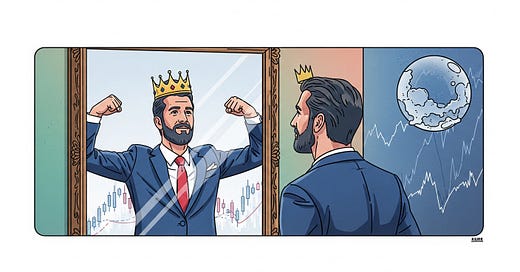Analyzing public companies and investing is fun!
You get to make sense of a lot of financial and non-financial data, both qualitative and quantitative.
But, there's something that is rarely analyzed—your mind.
While diving into numbers and trends, it is easy to overlook your subconscious biases that influence the decisions you make.
1.0 Confirmation bias
I want to start with this one, as I think it's the most common.
As investors, we want to be right. So when we see information that supports our investment thesis, it gives us a good feeling.
When social media is added into the equation, especially Reddit/Twitter(X), this becomes a problem. The average person tends to follow people they like and engage more often with them. As the algorithms are built to keep you engaged, they’ll only recommend similar content, meaning you see content that supports your thesis way more than opposing content.
The ratio between the two might be so significant that when you come across a negative article or post, you dismiss it.
The most effective way to counteract this bias is to seek out opposing views actively.
Bonus: I recall one specific individual who claimed that rising interest rates were good for Tesla. His rationale was that Tesla could lower the prices and sell more cars.
When interest rates were declining, the same individual argued that this was also good for Tesla, because the cars now cost less.
If you are biased, it is easy to fool yourself and make a case why whatever happens out there is good for the company you own.
2.0 Anchoring bias
If you’ve bought a share at $100, and it drops to $70, you might anchor on that $100 purchase and think, “I’ll sell when it gets back to what I paid.”
This decision is based on your initial purchase, rather than the company’s fundamentals.
A key way to fight this is to always ask the question, “Knowing what I know now, would I buy this stock today, at its current price?”
3.0 Overconfidence bias
This is particularly common in bull markets, when prices are rising and everyone appears to be a genius.
The average investor feels more knowledgeable, taking bigger risks and overlooking warning signs. This plays a role in the creation of market bubbles.
It is crucial to stay humble, step back, reassess, and let the data guide the decisions, rather than an inflated sense of certainty.
4.0 Herding bias
When Berkshire Hathaway announces a new company as part of its portfolio, the share price goes up on the news. Investors often mimic Buffett’s decisions without conducting their own thorough research.
Although Warren Buffett is outstanding, numerous examples are not so positive, such as the rise of meme stocks. In these cases, primarily retail investors, driven by social media, collectively pushed certain stocks to unsustainable levels.
Independent thinking is the cure to this. Even when you are exposed to information of this kind, do your due diligence.
Understand what you’re buying, and why.
5.0 Recency bias
As human beings, we remember what happened yesterday more vividly than what happened a year ago. Since the recent information is what our brain processes, it feels more relevant.
But not all new information is relevant. There is a tendency to overestimate the importance of recent events or data points, at the expense of the broader picture.
Those who are guided by their emotions tend to react quickly to recent headlines, abandoning their investment thesis and long-term strategy.
There is a lot of data that supports this, ranging from chasing “hot” stocks or sectors that have performed exceptionally well lately, to being pessimistic about the market after a correction and selling assets.
To combat this, avoid making impulsive decisions based on short-term market noise.








